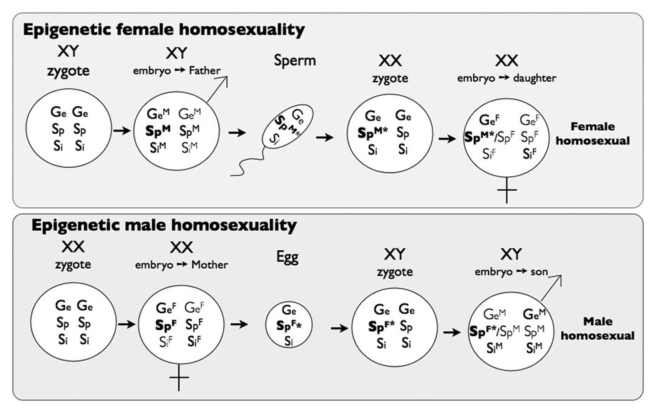@leatherbear:
The scientists in Koebler's article, in my view, are now resorting to genetic subterfuge and are coming dangerously close to saying that homosexuality is the result of a genetic defect, a genetic abnormality. In other words, read from one angle, these same scientists are saying that homosexuality is the result of a birth defect. All this in an effort to maintain some ever thinner thread of connection between biology and homosexuality.
I do not for one moment believe that homosexuality is pre-determined, either genetically or epigenetically. "
The hypothesis for an epigenetic cause of homosexuality put forth by these scientists can be described as a series of statements:
1. Empirical studies demonstrate that XX fetuses are canalized to blunt androgen signaling (lower sensitivity to T) and XY fetuses are canalized to boost androgen signaling (higher sensitivity to T).
2. Empirical studies demonstrate the production of XX- and XY-induced epi-marks in embryonic stem cells and extensive sex-specific differences in gene expression at this time. Epi-marks laid down during the embryonic stem cell stage are also established to influence gene expression later in development. This stem cell period is the most plausible candidate time point for the production of epi-marks influencing sensitivity to androgens later in development (canalization of fetal androgen signaling).
3. Epi-marks produced in embryonic stem cells are mitotically transmitted to cell lineages leading to both the soma and the germline, and contribute to pseudo-heritability when they escape erasure across generations (nonerasure in the primordial germ cells and in the zygote and first few cell divisions of the next generation). Animal models as well as human data unambiguously demonstrate that such a multistep escape from erasure does occur at nontrivial frequency.
4. Epi-marks blunting (in XX fetuses) or boosting (in XY fetuses) androgen signaling will be sexually antagonistic (SA-epi-marks) when they have a nonzero probability of carryover across generations and are expressed in oppose sex descendants. Such carryover will contribute to discordance between the gonad and one or more sexually dimorphic traits.
5. The modeling work done by these scientists shows that SA-epi-marks are favored by natural selection over a broad span of parameter space because there is a net benefit to the carrier (due to canalization of sexually dimorphic development) that is not offset sufficiently by transmission (and fitness reduction) to opposite sex descendants.
6. Genetic mutations causing SA-epi-marks are expected to fix in populations and are therefore not expected to be polymorphic except transiently during their initial spread within a population. Therefore, no association between genotype and homosexuality is predicted.
7. Because the androgen signaling pathways differ among organs and tissues (e.g., use of different AR cofactors), the same inherited SA-epi-mark can affect only a subset of sexually dimorphic traits, e.g., no effect on the genitalia, but a large effect on a sexually dimorphic region of the brain.
8. Shared, gonad-discordant SA-epi-marks that carryover across generations would contribute to the observed realized heritability of homosexuality, e.g., monozygotic twins share the same SA-epi-marks coinherited from a parent.
9. Unshared, gonad-concordant SA-epi-marks, produced during fetal development, would contribute to the low proband concordance of homosexuality observed between monozygotic twins, i.e., they need not share SA-epi-marks generated during development that occurs after the twins have separated.
10. Homosexuality occurs when an individual inherits one or more gonad-discordant SA-epi-marks that are not masked nor erased by the production of de novo gonad-concordant SA-epi-marks that accrue during ontogeny. The SA-epi-mark(s) influence androgen signaling in the part of the brain controlling sexual orientation, but not the genitalia nor the brain region(s) controlling gender identity.
An illustration of these steps:

Reference
W.R. Rice, U. Friberg, S. Gavrilets, et al. (2012) Homosexuality as a Consequence of Epigenetically Canalized Sexual Development. The Quarterly Review of Biology, p. 000. The University of Chicago Press. DOI: 10.1086/668167
 Feelings are in the long-term more beneficial to us and to our concept of morality precisely because we have limited control over their emotional effects. This limited control introduces an element of unexpectedness to what we experience, and people invariably learn more from unexpected things in life than they do from the expected ones.
Feelings are in the long-term more beneficial to us and to our concept of morality precisely because we have limited control over their emotional effects. This limited control introduces an element of unexpectedness to what we experience, and people invariably learn more from unexpected things in life than they do from the expected ones.
